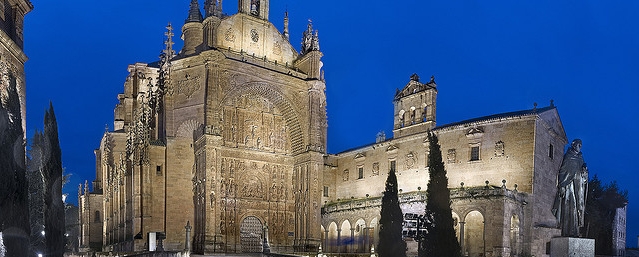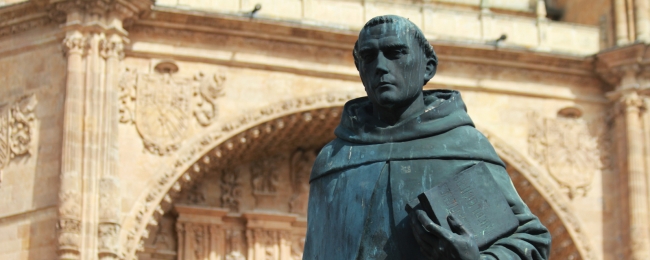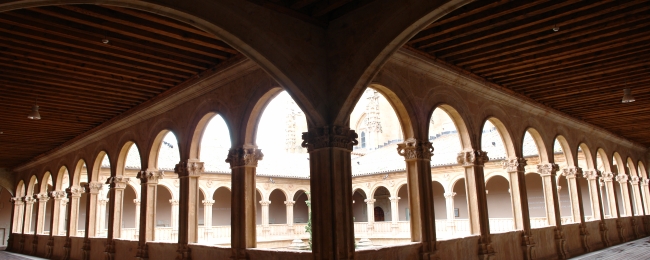The Order of Preachers was founded in Toulouse (France) in 1215 by St. Dominic de Guzmán, a Spanish Canon (ca. 1170-1221) and approved in 1216 by Pope Honorius III.
Two years later in 1218, the University of Salamanca was established and most probably, St Dominic ordered to establish a Convent in that city since he wanted his friars to be present at university cities.
However, St Dominic did not see the realization of this foundation, since he died in 1221and it was probably the following year when the first Dominicans settled in Salamanca, outside the city walls, near the Tormes River, at the Church of San Juan el Blanco, to which they attached their Convent. They were living there until a flooding of the Tormes in 1256 swept away the church and the Convent.
That same year, the Bishop of Salamanca gave them the Church of San Esteban, a little Romanic temple, inside the city walls, with its cemetery and adjoining possessions. The friars decided to build in this new location a Gothic church with three naves and a convent with its cloister and outbuildings. From all these constructions of the thirteenth and fourteenth century, we only have some rare vestiges.

The Convent of San Esteban, almost since its beginnings, was dedicated to be a centre of study and teaching of Theology. Here, in 1299, was established the General Centre of Studies for the Dominicans in Spain. On the other hand, the principal education at the University (founded in 1218) was Law. Theology was introduced at the University in the fourteenth century, when four chairs of Theology were established. Two of them will be held by the Dominicans of San Esteban. The teaching of Theology at the university and at San Esteban was constant until well past the 17th century.
At the end of the 15th century, overcoming the ills of the cloister caused by the Black Plague (14th century), characterized by the decline in religious life, the Convent initiated its epoch of greatness.
We must remember above all, Brother Diego de Deza (protector of Columbus, private tutor of Prince Juan, bishop of Palencia, and archbishop of Sevilla). During his time is placed the coming of Christopher Columbus to Salamanca and his stay at the Convent (about 1486-1487) where he found the support that will be later given to him by the Board of Professors of Salamanca.
In the 16th century, the University of Salamanca led by the great theologians of San Esteban, attained its highest prestige. The greatest of all the Masters was Brother Francisco de Vitoria (1483-1546), founder of “the Salamanca School”, creator of International law, defender of human rights, which he related to the American natives in his famous Second Magisterial Lectures (Relecciones – these were public lectures given as an expansion of what had been given in class). Next to him stands out Brother Domingo de Soto (1495-1560), eminent mind and a very prominent theologian at the Council of Trent.
The list of masters, professors and bishops from this Convent is very long: Cardinal Juan Alvarez de Toledo, Melchor Cano, Juan de la Peña, Bartolomé de Carranza, (archbishop of Toledo), Diego de Chaves, Pedro de Sotomayor, Bartolomé de Medina, Mancio de Corpus Christi, Antonio Hontiveros, Domingo Báñez, Pedro de Herrera, Francisco Araujo, etc…

This rich history of San Esteban is completed with its contribution to the Evangelization of America and the Philippines. In 1509, the friars of this Convent decided to commit themselves to the missionary task in the new lands recently discovered in America. To this convent belongs the first Dominicans that arrived at the Island of La Española (or Hispaniola, also called the Island of St Dominic – what is today Haiti and the Dominican Republic) in mid-September of 1510.
Brother Antón Montesinos preached his first sermon, in defence of the Indian rights - “Are they not men?” -, against the colonists’ oppression (to which the Indians were subjected by the “encomenderos” – those who had charge of groups of Indians) there on 21 December 1511. To this group was later joined an “encomendero” turned priest, Bartolomé de las Casas, who, converted by the preaching of Montesinos, became a Dominican in the same Convent.
During the Independence war, the Convent of San Esteban was occupied by French troops in 1809. Apart from some images, reliefs, columns, etc…they did not destroy much, but seized all (or almost all) the gold and silver objects of the Convent. The friars had to abandon the building which served as headquarters of Napoleon’s troops until 1813.
With no time to recover from the consequences of the war against the French, the liberal Spanish government decreed the abolition of religious Orders. At San Esteban, the decree was enforced in 1835. Buildings were abandoned and some zones were used for headquarters and infirmary. From this ruin, only the Church was saved, due to the wise and provident determination of the bishop of the city, who converted it to a parish. With it, the sacristy also escaped. All the furniture and library of the Convent were however plundered.
It was in such a ruined situation that, according to the chronicles, in 1855 the building began sinking. An intellectual group from Salamanca raised its voice in order to save the Convent due to its artistic and historical value. So, in 1861 it was proposed to locate there the Provincial Museum of Salamanca. This was set up on the two floors of the Cloister of Processions. This led to a partial restoration, which affected above all, those areas used as Museum.

In 1880, the French Dominicans from Toulouse, expelled by the French authorities, were allowed to occupy the Convent in its ruins. They were joined by four exclaustrated Spanish friars. There were about fifty friars there, among them about thirty students, who lived in the Convent for seven years. Among them is worth remembering Father Marie Joseph Lagrange, inspirer of modern exegesis in the Church, founder of the famous Biblical School of Jerusalem and its journal, the Revue Biblique.
The restoration of the Dominicans of San Esteban was due to the four Spanish friars who came to live with the French. The definitive boost was in September 1892, when the Convent was established as a formal house with a Prior. In 1897, it became (again) a General Centre of Studies and was raised to a Theology Faculty in 1947.
As you can see on this webpage, at present the community consists of about thirty Dominican Friars devoted to study, preaching, and teaching Theology. The Theology Faculty continues and there are, likewise, other institutions related to the intellectual life such as the Library, the Dominican Historical Institute with its Archives and the publishing House San Esteban.
Cf. Lázaro Sastre, St. Stephen´s priory. Art and History of Dominicans, Edilesa, León 2001, 2-10.